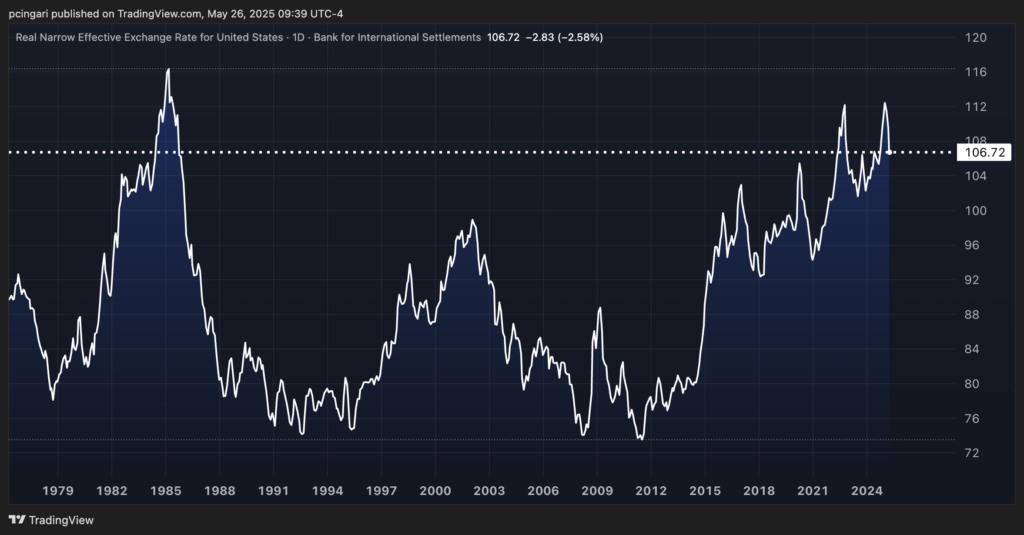
With the U.S. dollar trading 15–20% above its long-term fair value, analysts at KKR & Co. Inc. believe the era of dollar-fueled outperformance in U.S. assets is likely close to an end, as global investors begin shifting away from a decade of American exceptionalism.
Is The US Dollar Overvalued?
While the U.S. Dollar Index (DXY)--tracked by the Invesco DB USD Index Bullish Fund ETF (NYSE:UUP)--has dropped 9% year-to-date, the greenback still appears significantly overvalued when viewed through a long-term lens.
In its latest May’s Global Macro Trends report, KKR showed that the real effective exchange rate of the dollar now sits at a 16.6% premium, as of May 2025.
This marks only the third time since the 1970s the greenback has crossed the 15% threshold. The last two times -- in March 1985 and February 2002 -- were each followed by prolonged bear markets for the dollar.
In 1985, the dollar reached a peak of 30.5% overvaluation before falling for a decade following the Plaza Accord. In 2002, the dollar peaked at 15.7% and slid into a similar long decline, eventually trading more than 13% below fair value by 2011.
While capital inflows may continue to support the dollar in the short term, KKR suggests the setup today resembles the early 2000s more than the 1980s.

Is This the Start of A Dollar Downcycle?
Despite notable differences from past cycles--such as stable oil prices and weaker Chinese growth--KKR analysts expect a gradual correction ahead.
“We do not expect the next downcycle to be as rapid or pronounced as it was 20-odd years ago,” they said, “but history indicates the dollar is likely to revert to trading at a discount on a real effective exchange rate basis.”
In other words, the greenback could eventually dip below fair value and remain weak for years, unwinding its overvaluation through a long, steady slide rather than a crash.
What Happens If The Dollar Falls?
While a weaker dollar reduces the global purchasing power of U.S. investors, it has notable upsides. It boosts the competitiveness of American manufacturers, which can support job creation domestically.
At the same time, it helps reduce the debt burdens of emerging markets and global corporations that hold dollar-denominated liabilities.
Additionally, a softer dollar improves the purchasing power of consumers abroad, particularly in Europe and Asia, potentially rebalancing the global consumption dynamic that has long relied on the strength of the U.S. consumer.
This shift could relieve the U.S. consumer--long the engine of global growth--by redistributing demand more evenly across geographies.
Why Global Investors Are Paying Attention
KKR's latest note ties the currency discussion into broader asset allocation themes. Following April's "Liberation Day" announcement, which triggered sell-offs in both equities and bonds, CIOs and asset allocators are rethinking their U.S. exposure. Many now see dollar weakness as a structural trend that demands more geographic diversification.
"Truth be told," KKR wrote, "many investors have probably enjoyed an unsustainable run of excess U.S. returns." As the dollar normalizes, those returns may become harder to replicate--unless portfolios are rebalanced to include more non-U.S. assets.
Ultimately, KKR's view is that while the dollar won't collapse, it also won't continue to support outsized U.S. valuations forever. This could mark the start of a multi-year transition to a more balanced global investment landscape.
Read now:
- 30-Year Treasuries Offer Contrarian Entry Point: Buy ‘Humiliation,’ Bank Of America Investment Strategist Says
Image: Shutterstock/Claudio Divizia



